Growing plants in pots are one of the best ways to bring plants into our home, patio, or backyard.
And if we can grow some beautiful and colorful flowers in them, what else would someone ask for.
So, in this article, we shall share 17 beautiful and easy-to-grow flowers that you can grow in pots. So, let’s get right into it.
Azaleas
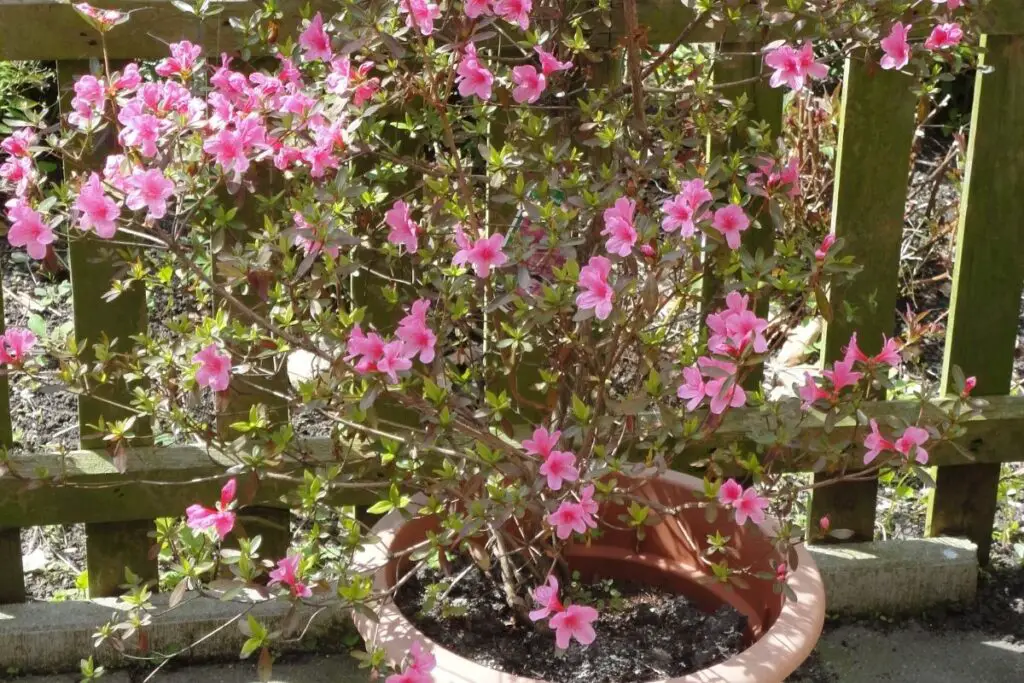
Azaleas have gorgeous blooms and look even more beautiful when grown in pots and kept indoors. With regular pruning, you can grow them in containers, and it resembles small trees. You can choose from varieties of shapes and colors from its different species.
Sunlight: Azaleas like a lot of light but may suffer indirect light. Please keep them in partial shade or indirect bright light for long hours each day for best growth and health. Low light will inhibit bushy growth and flowering.
Watering: Water azaleas in regular intervals when the soil is halfway dry. Do not overwater as it can easily get prone to pests and root rot. Also, do not let the plant dry in hot weather.
Fertilizer: Feed azaleas with slow-release balanced food in the dormant period between late fall or early spring. They are light feeders and can even do without fertilizing.
General care: Azaleas like warm temperatures but will suffer in temperature levels above 85°F. Avoid keeping them near heating systems and move them indoors in freezing temperatures.
Calla lily
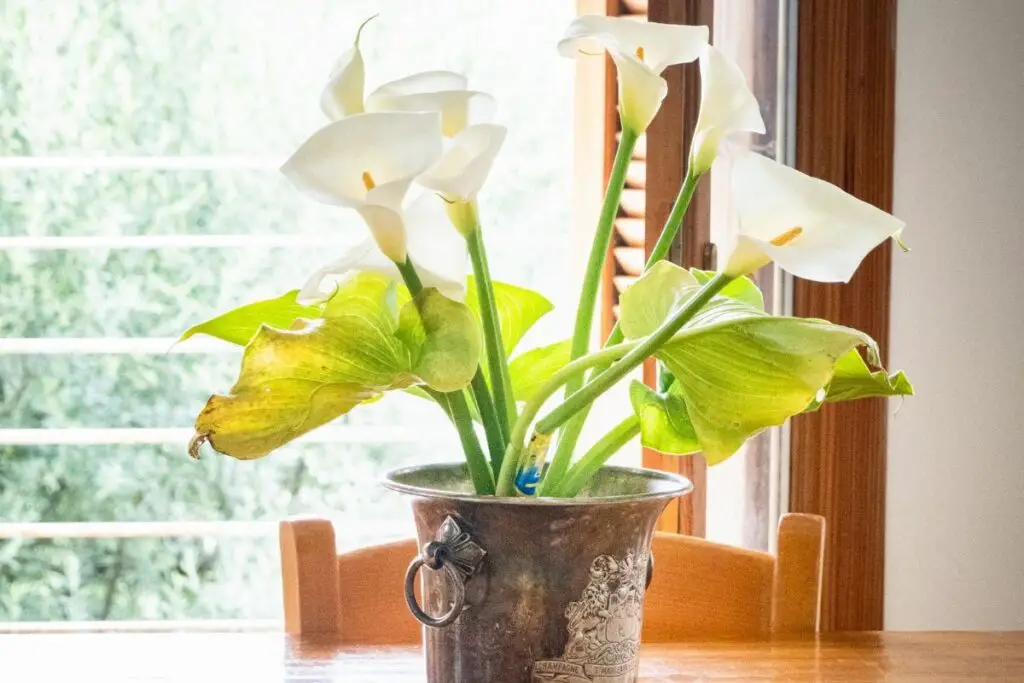
Calla lily has curled white flowers in trumpet shape, and it comes in colors like pink, orange, or red. It has dark green leaves. It can grow up to 24 inches and can be grown in containers that beautify your indoors.
Sunlight: Calla lily likes a lot of light to grow well and flower abundantly. You can keep them in indirect bright light or part shade during hot months. During cooler months, you can expose them to the full sun too.
Watering: Water calla lily in regular intervals to keep the soil moist. Do not overwater as it can lead to root rot and attract pests. Hold watering after the plant has flowered and starts to die back until the next growing period.
Fertilizer: Feed calla lily in the right dose with a bulb fertilizer monthly. Stop feeding once the plants have bloomed. Do not over-fertilize, as it leads to salt buildup and other problems.
General care: Keep your calla lily indoors in warm temperatures during freezing temperatures. If the plant dies due to cold, you can dig its bulb in the fall to save it for the next growing season. Use neem oil solutions as a preventive measure for pests.
Celosia
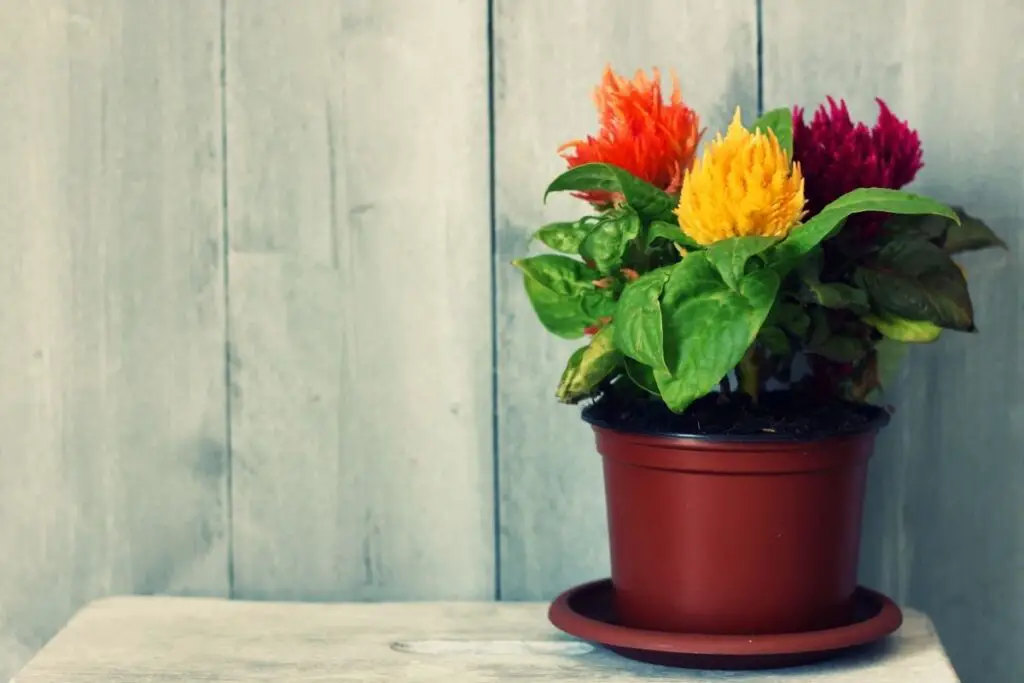
Celosia is a plant with unusual-looking flowers famously known as wool flowers. Its flowers are available in various colors like red, pink, gold, purple, etc. They can be grown in containers with minimal effort.
Sunlight: Keep your celosia plant in full sun if you want better blooming. Keeping them in low light can inhibit their blooming and also lead to weak plants.
Watering: Water celosia in regular intervals during hot weather to keep the soil evenly moist. Do not overwater and ensure proper drainage. During cooler months, water only when the soil is fully dry.
Fertilizer: Feed celosia with high content fertilizer or compost once a month in the growing season. Do not overfeed the plant; fertilize by diluting the recommended dosage to half the strength.
General care: Keep your celosia in warm temperatures and average humidity. Exposing them to freezing temperatures may lead to their death too.
Chamomile
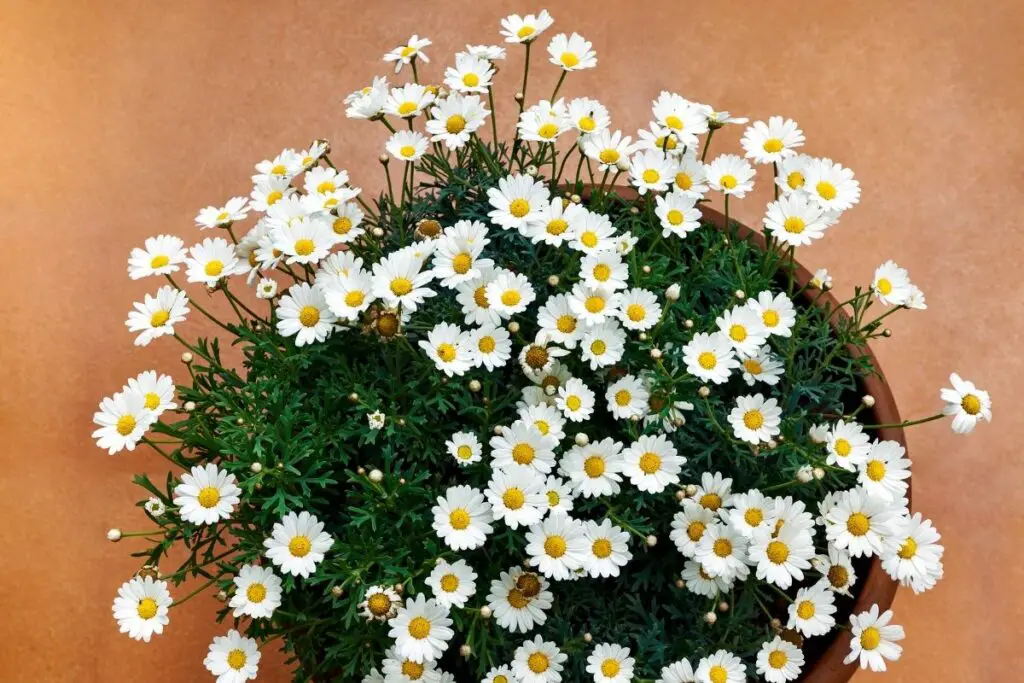
Chamomile is a gorgeous flower plant that has white petals and is fragrant. It can grow about a foot tall and looks beautiful when grown in pots. Choose a large container for these plants for their best performance.
Sunlight: Chamomile likes and needs a lot of light to grow well. They appreciate full sun to partial shade for optimum growth. During harsh afternoon sun, you can keep them in partial shade.
Watering: Water chamomile in regular intervals to keep the soil moist. Do not overwater and ensure a proper drainage system. You can feel the soil before watering, dig your finger and check if the soil is dry and water accordingly.
Fertilizer: Feed chamomile with slow-release fertilizer or diluted balanced fertilizer. Feed once a month in the growing season but avoid extra supplements.
General care: Keep chamomile in warm temperatures but bring them indoors or keep them in the shade in high-temperature levels during hot summers.
Looking for gardening supplies? We have tested 100's of products before recommending them to you guys. Check out our best pick below:
| Image | Gardening Supplies | Best Price? |
|---|---|---|
 Top
Top Top
Top | Raised Garden Bed Kit | Check On Amazon |
 | XLUX Soil Moisture Meter, Plant Water Monitor, Soil Hygrometer Sensor for Gardening, Farming, Indoor and Outdoor Plants, No Batteries Required | No Results |
 Top
Top Top
Top | 82 Pcs Garden Tools Set and Extra Succulent Tools Set | Check On Amazon |
 | Joeys Garden Expandable Garden Hose with 8 Function Hose Nozzle, Lightweight Anti-Kink Flexible Garden Hoses, Extra Strength Fabric with Double Latex Core, (50 FT, Black) | No Results |
 Top
Top Top
Top | Dual Chamber Compost Tumbler | Check On Amazon |
 Top
Top Top
Top | Sunnyglade Plant Stakes | Check On Amazon |
 Top
Top Top
Top | Organic Cold Pressed Neem Seed Oil | Check On Amazon |
 Top
Top Top
Top | Mighty Mint Gallon :-Insect and Pest Control Peppermint Oil | Check On Amazon |
 Top
Top Top
Top | Scotts DiseaseEx Lawn Fungicide | Check On Amazon |
 Top
Top Top
Top | Jacks Classic 20-20-20 All Purpose Fertilizer | Check On Amazon |
 Top
Top Top
Top | 30,000 Seeds Pollinator Attracting Wildflower Mixture | Check On Amazon |
 Top
Top Top
Top | Survival Vegetable Seeds Garden Kit-Over 16,000 Seeds | Check On Amazon |
Chrysanthemum
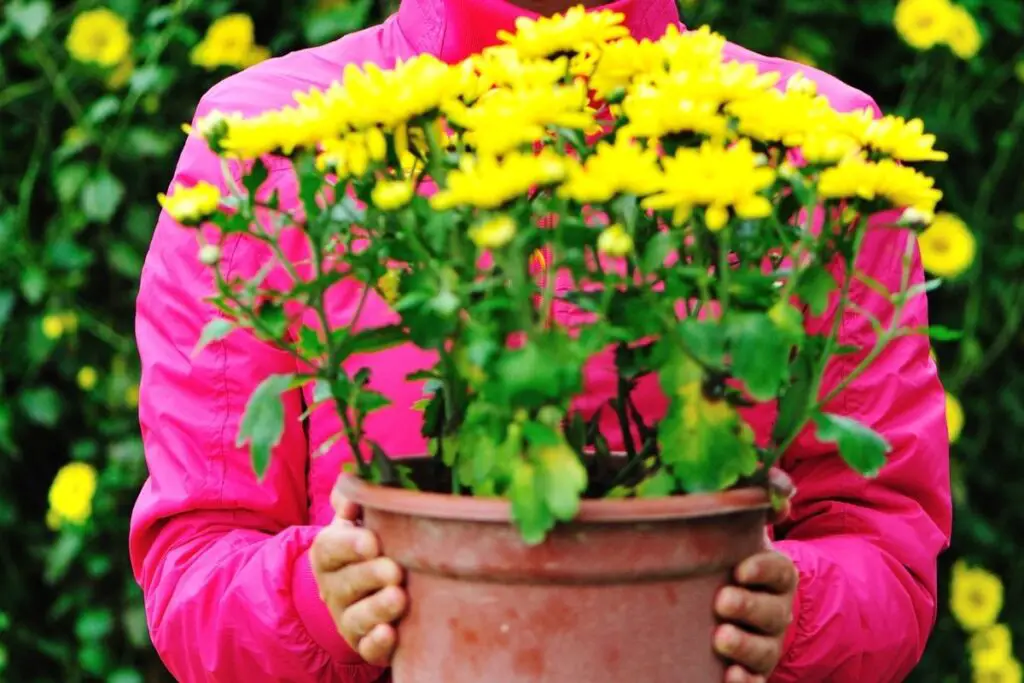
Chrysanthemum comes in varieties and is perfect for a container garden. They produce gorgeous blooms in different colors like pink, yellow, orange, red, purple, and white, and some varieties even bloom throughout the fall season. They need some attention to grow well and produce flowers abundantly.
Sunlight: Chrysanthemum appreciates a lot of light; they do well in full sun. During hot summer months, you can keep them in partial shade during afternoons.
Watering: Water chrysanthemum to keep the soil moist. You can check the soil’s moistness by digging a finger or sticking it in the soil and taking it out after a few minutes. If the soil is sticking to it, it is still moist.
Fertilizer: Feed chrysanthemum in the growing period with diluted flower fertilizer. Do not fertilize when the flower buds have formed.
General care: Chrysanthemum is a hardy plant and can tolerate various temperature levels. It is best to choose a variety of chrysanthemums according to your zone. Pinch off new growth till they are ready to bloom for a full and bushy plant.
Daffodils
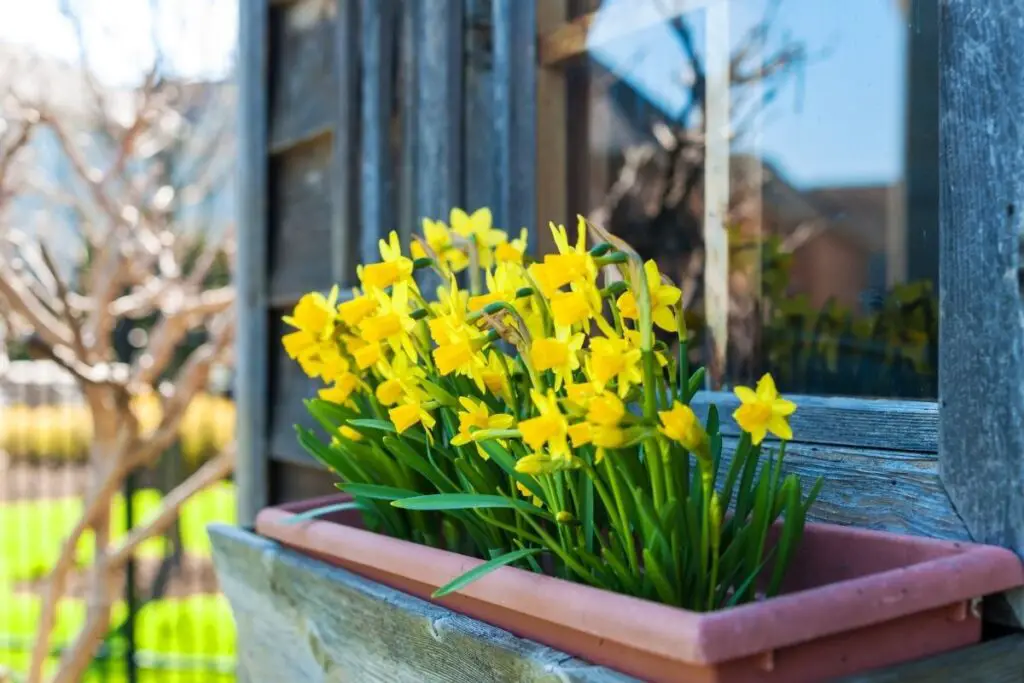
Daffodils are beautiful flower plants with a trumpet-shaped flower surrounded by six petals with two colors. It has a pleasant smell and will do well in containers.
Sunlight: Daffodils need full sun and will perform best in full sun. Its growth and blooms will inhibit if kept in low light for longer months.
Watering: Water regularly after planting the bulbs and water thoroughly and ensure excess water drains out. Use light soil to facilitate proper drainage.
Fertilizer: Feed daffodils when root growth begins i.e. in the fall. Feed with a slow-release fertilizer low in nitrogen and high in phosphorus and potassium in the fall. In spring, feed with liquid fertilizer.
General care: Daffodils like cool to warm temperatures levels, ideally between 50°F to 75°F. They do best in cooler temperatures, especially the blooms. Remove debris or dead flowers when the plant turns yellow completely and cut them off at the ground.
Dahlia
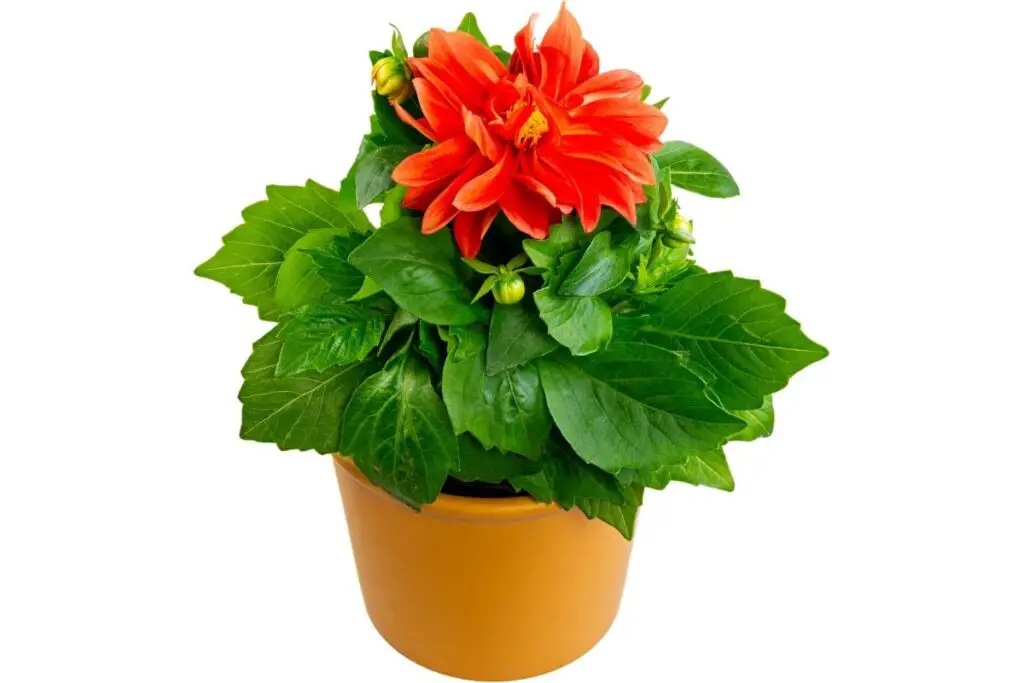
Dahlia produces beautiful flowers which come in all possible colors except for blue. The dwarf dahlia varieties grow best in containers, and you can choose from so many dahlia varieties to grow according to your preference.
Sunlight: If you want beautiful blooms, you must provide your dahlia with an abundance of light. They like full sun and will not flourish if kept in low light or shade for a long period.
Watering: Water dahlia in regular intervals and keep the soil dry. They do not appreciate dry soil, so water it regularly in hot summers. Do not overwater and let the excess water drain out.
Fertilizer: Feed dahlia monthly in the growing months with a diluted flower fertilizer. Choose a fertilizer with low nitrogen content. Avoid over-fertilizing as it can affect its growth and bloom.
General care: for tall dahlias, use stakes to support them. For planters living in cold weather, overwinter its tubers inside. Dig up only 2 weeks after the frost has passed. Cut the blooms in the cool morning to promote new blooms.
Daisies
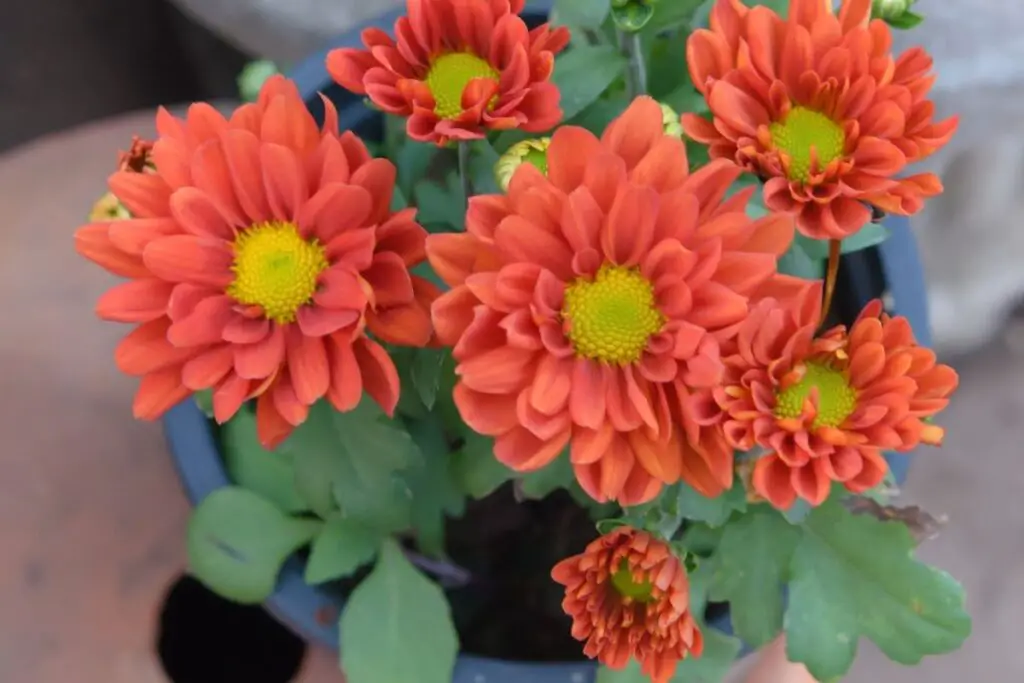
Daisies have flowers with a yellow center and white petals. They are easy to grow and bloom from early spring to late autumn, and they are perfect for growing in containers. There are other varieties too with different colored flowers.
Sunlight: Daisies grow well in good lighting. You can expose them to full sun and cast a shade over them in hot summers. Low light will inhibit its growth and blooming.
Watering: Water daisies when the soil is halfway dry from the top. Do not overwater your daisies as it can lead to root rot and later death of the plant. Check the soil from the top up to inches before watering to avoid overwatering.
Fertilizer: Feed daisies in the growing season with an all-purpose organic fertilizer until it blooms. Feed the plant monthly to grow a strong and sturdy plant.
General care: Deadhead daisies flowers to promote more blooms. Support tall daisies with stakes. They like cool temperature levels and can bear temperatures as low as 30°F.
Dianthus
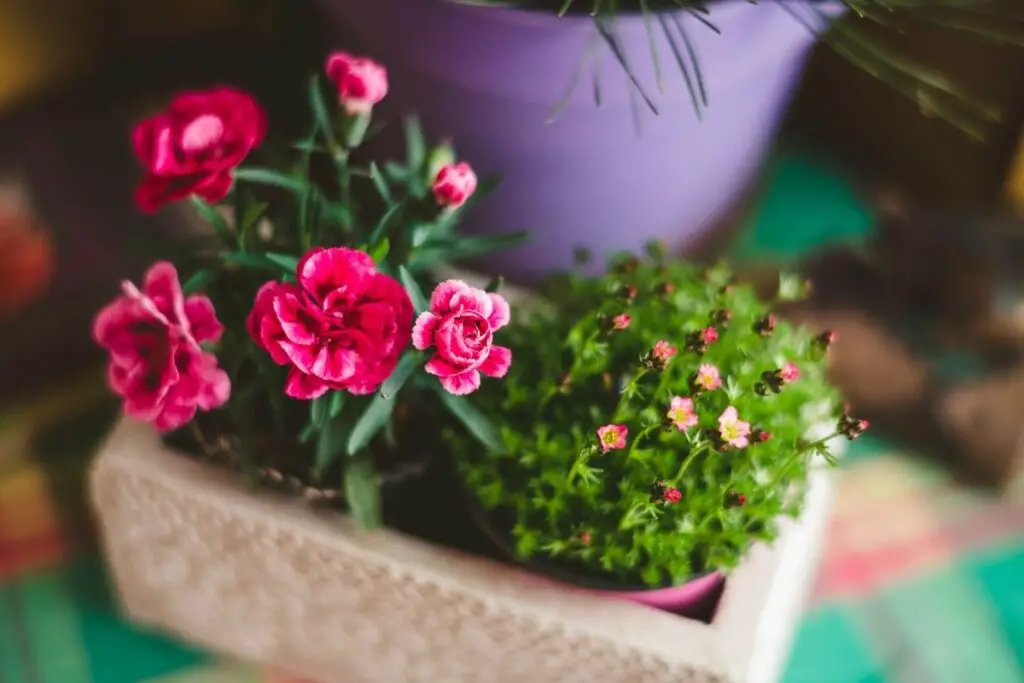
Dianthus is a beautiful flower plant with a splash of colors. There are many varieties, and different varieties produce different colored flowers. It grows up to 3 feet high, and you can choose from different varieties to grow to brighten up your container garden.
Sunlight: Dianthus likes full sun, but some of its varieties prefer partial shade. You must always check the variety of plants you grow for its preferences.
Watering: Dianthus likes moist soil, so water the plant to keep the soil moist but not drowning. Water when the top few inches of the soil is dry, and avoid letting the soil dry out completely.
Fertilizer: Fertilize dianthus once a month in the growing season. Feed with a flower fertilizer in the recommended dosage, and do not fertilize when the flowers have formed.
General care: Dianthus likes cool climates. Please keep them at temperatures around 60°F to 70°F. Protect them when the temperatures drop below 40°F.
Foxgloves
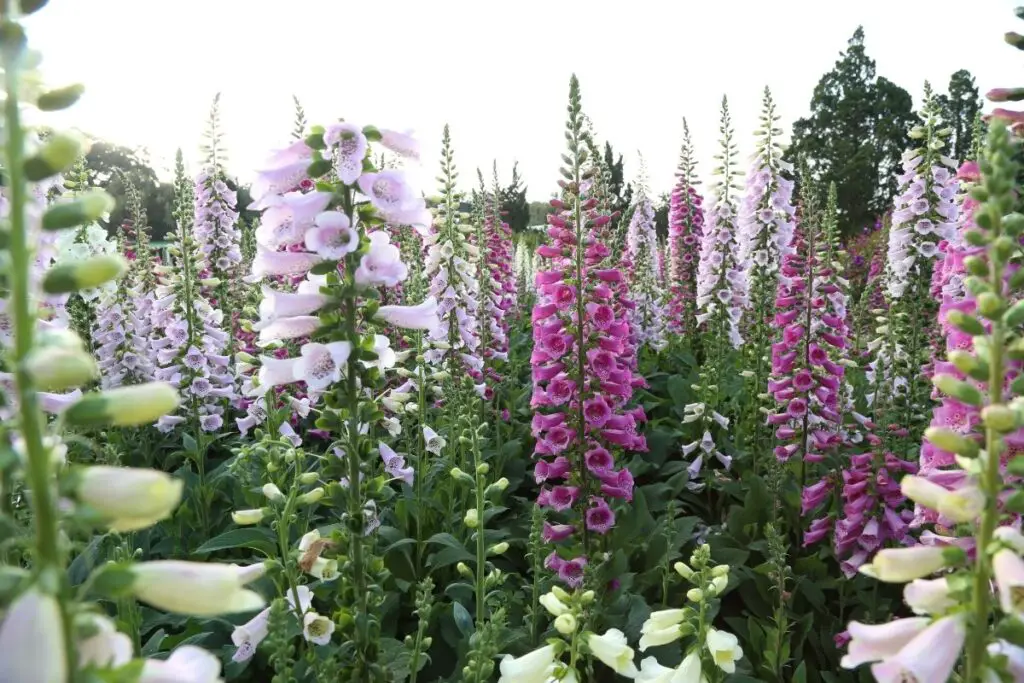
Foxgloves produce beautiful trumpet-shaped flowers in colors from purple to pink to white. It has fuzzy green leaves in a rosette form. They can be grown in plant containers and will flourish in favorable conditions.
Sunlight: Foxgloves will grow best in partial sun to a shady area. They will suffer in full sun, and direct sun will cause sunburn. Please keep them in such a spot where they can receive a lot of light but away from direct light.
Watering: Foxgloves like evenly moist soil and will suffer if the soil stays soggy for a long period. Water foxgloves when the soil is halfway dry, and check the soil before watering to avoid overwatering.
Fertilizer: Fertilize foxgloves with liquid flower food monthly in the growing season. Do not over-fertilize as it can inhibit flowering and lead to salt buildup.
General care: Foxgloves like cooler weather and cannot tolerate too much heat. Keep them indoors during too-high-temperature levels. Remove the flower spike when the flowers start to die to promote the plant bloom again.
Geranium
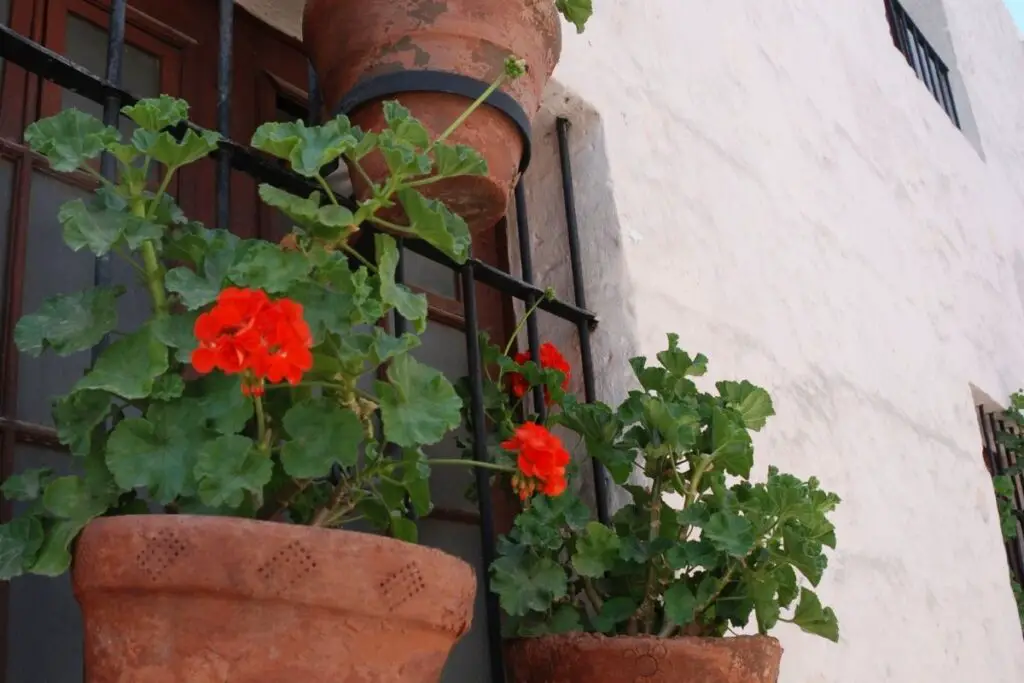
Geranium is an easy-to-care flower plant with flowers in different colors like pink, red, white, purple. They bloom abundantly from spring to fall. They are perfect for balcony gardens and plant containers.
Sunlight: Geranium needs full sun to grow well and to bloom abundantly. If you keep them in low light or shade for a long period, then they will not bloom or grow to their best. Some varieties grow best in full sun too.
Watering: Keep the soil of geranium moist or dry but not wet or dry. Overwatering will lead to root rot, so ensure watering when the soil is dry. Check the drainage system of the pot.
Fertilizer: Geraniums growing in containers indoors have low fertilizer requirements. Feed the plant monthly with a balanced fertilizer when it is actively growing.
General care: Geraniums lie to stay root-bound and should not be repotted frequently. Overwinter geraniums if there is a cold climate. They prefer temperature levels between 60°F to 70°F.
Impatiens
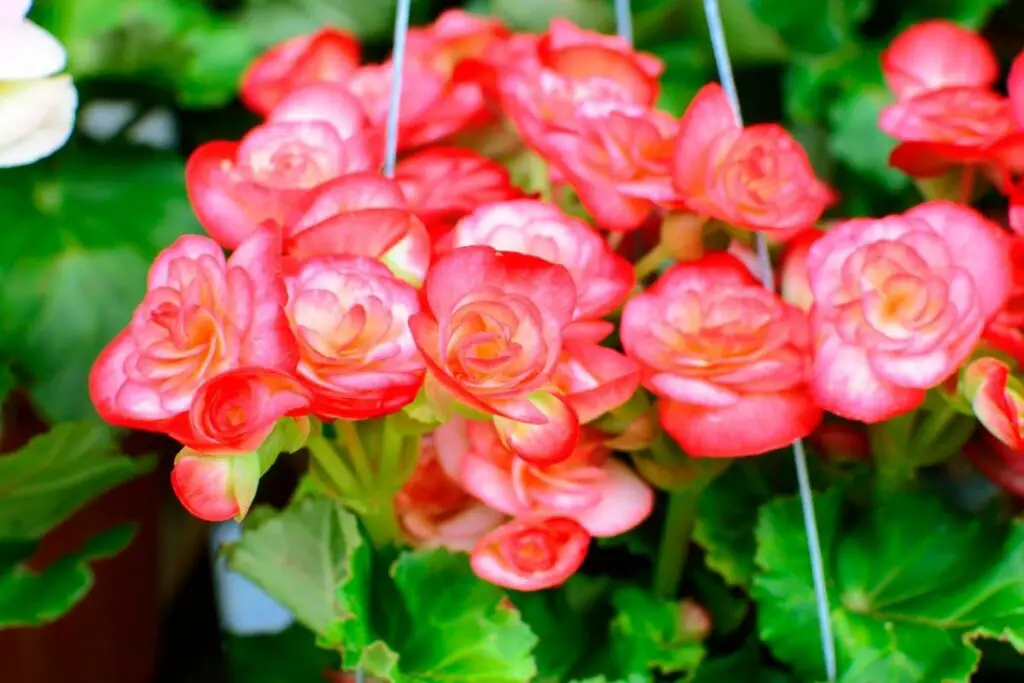
Impatiens produce beautiful bright flowers in colors like white, pink, violet, red, purple, coral, etc. they grow up to 1 foot high, and some of its varieties grow even shorter. They grow well in containers and even in window boxes.
Sunlight: Impatiens can grow in almost all lighting but grows best in full sun. The more light they receive, the more healthy and strong they grow.
Watering: Water impatiens when the soil is dry. Check the soil every few days by digging a finger in the soil to check the soil’s moistness. Water the impatiens to keep its soil evenly moist but never soggy.
Fertilizer: Fertilize your impatiens with slow-release fertilizer as it is a light feeder. Feed in the mid-summer with a small dose of fertilizer to boost its growth. Avoid over-fertilizing as it will inhibit flowering.
General care: Impatiens like warm temperatures, and during cold weather, keep them indoors till the temperature gets above 50°F. They can grow well in humid conditions. Trim impatiens if the plant is growing thin from the top.
Lavender
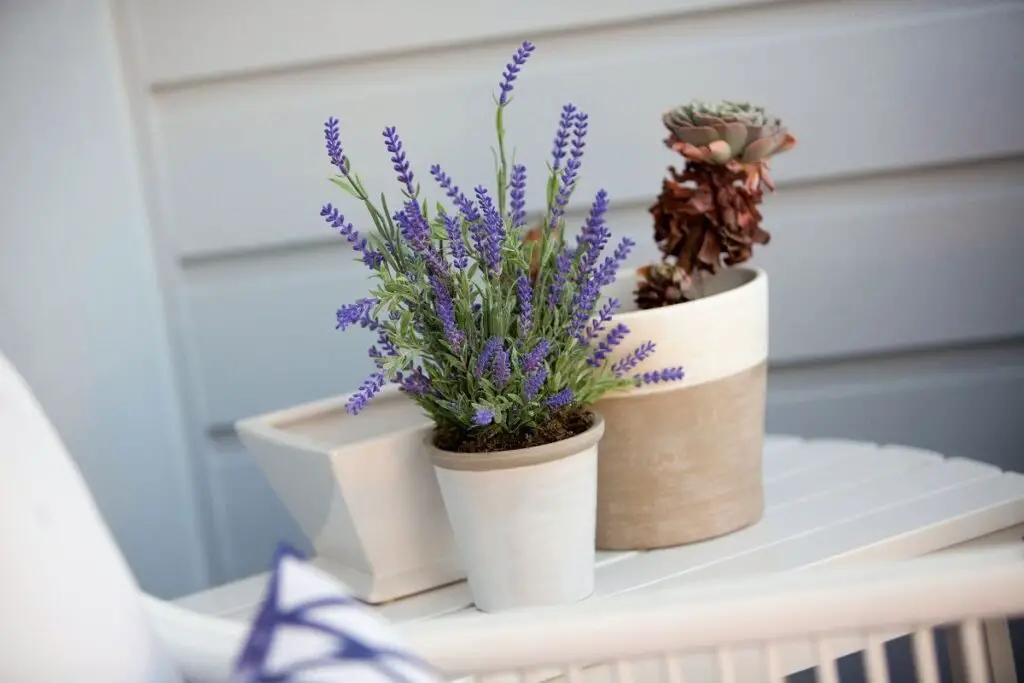
Lavender is a cheerful aromatic plant with purple-blue flowers. It is an attractive plant and will brighten your space when grown in containers. It has gray-green spikes like leaves adding to the beauty of the plant.
Sunlight: Lavender to grow and bloom abundantly needs a lot of light. Keep them in full sun. Keeping them in low light or a shady area will inhibit their growth and flowering.
Watering: Water lavender to keep the soil evenly moist but not soggy. Lavender is drought tolerant and will suffer if overwatered. Water them only when the soil is dry and needs water.
Fertilizer: Feed lavender before the active growing season in the spring. Feed with a slow-release fertilizer and do not over-fertilize.
General care: Trim lavender in early fall to keep it healthy and bushy. Avoid keeping them in humid conditions and keep them in warm temperatures for best results.
Marigold
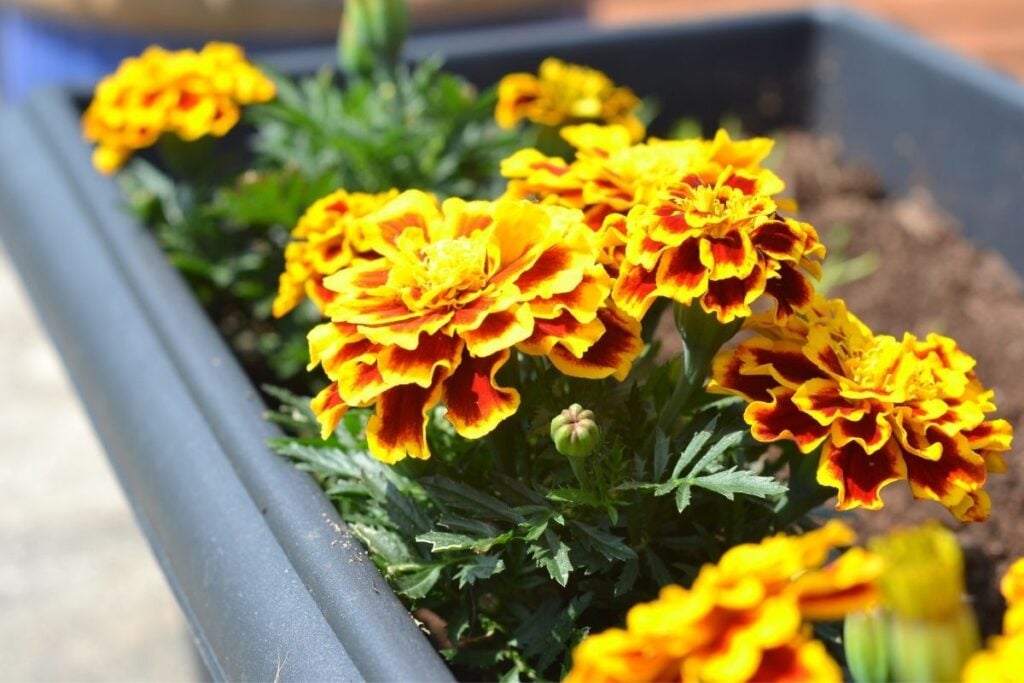
Marigold is a gorgeous flowering plant producing gold, yellow, orange, or white-colored flowers. They are easy to grow, have low maintenance with beautiful blooms, and grow abundantly even in containers.
Sunlight: Marigold grows well in partial to full sun. They can even grow in intense heat and unfavorable lighting. Proving them in good light will lead to abundant flowering.
Watering: Water marigold and keep the soil evenly moist but not soggy. Let the soil dry halfway before watering. Make sure to let the excess water drain out from the drainage system to avoid sogginess.
Fertilizer: Fertilize marigold with diluted liquid fertilizer occasionally, preferably when it starts blooming. Do not feed them in the growing phase as it may affect the plant’s blooming. Marigold can grow without fertilizer, even in poor soil.
General care: Marigold prefers war temperature and humid conditions. You can use 1 tsp dried mustard powder in the soil and water the plant to allow the powder to distribute evenly in the soil. It will lead to better and bigger blooms.
Morning glory
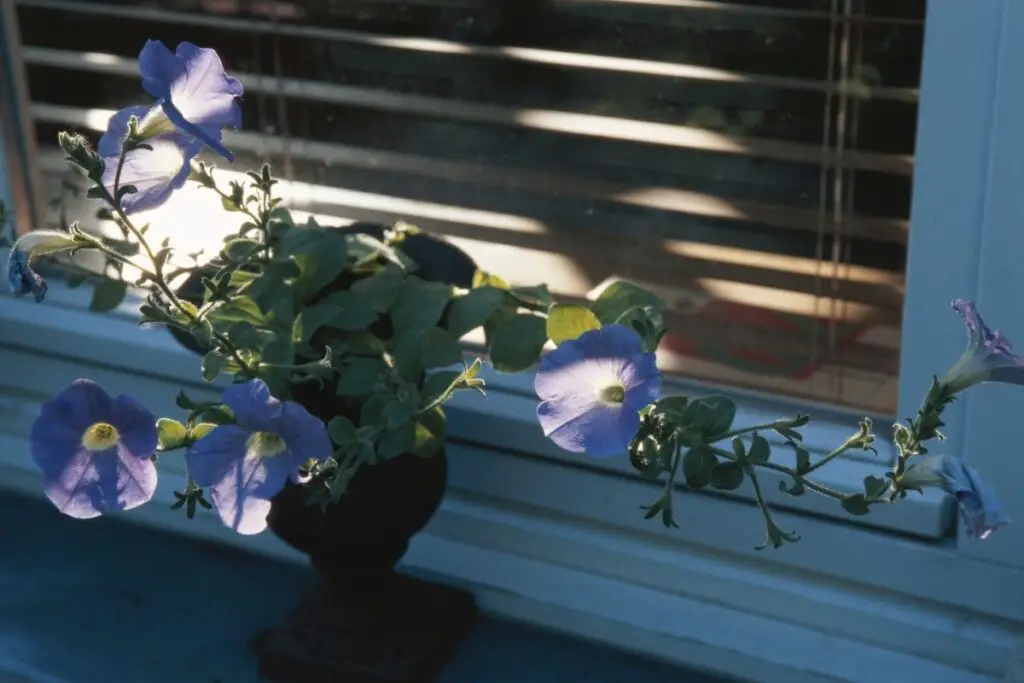
Morning glory has trumpet-shaped flowers. It is a climbing vine that blooms in the morning and lasts for one day only. They produce flowers in various colors like purple, pink, white, red, blue and will grow well even in pots. They bloom from mid-summer to late fall.
Sunlight: Morning glory grows best in full sun and can grow in indirect light too. If kept in low lighting for a long period, the plant may not grow and bloom to its optimal growth.
Watering: Water morning glory every few days to keep the soil evenly moist. Let the soil dry but not bone dry and ensure proper drainage.
Fertilizer: Fertilize morning glory with balanced liquid fertilizer after planting. After blooming, feed it with high-phosphate food to promote abundant flowering.
General care: Morning glory likes warm temperatures, and it will suffer in cool temperatures, and they can even die in frost. Use a string or trellis to support its vines and use the seeds for the future in the balcony garden.
Orchids
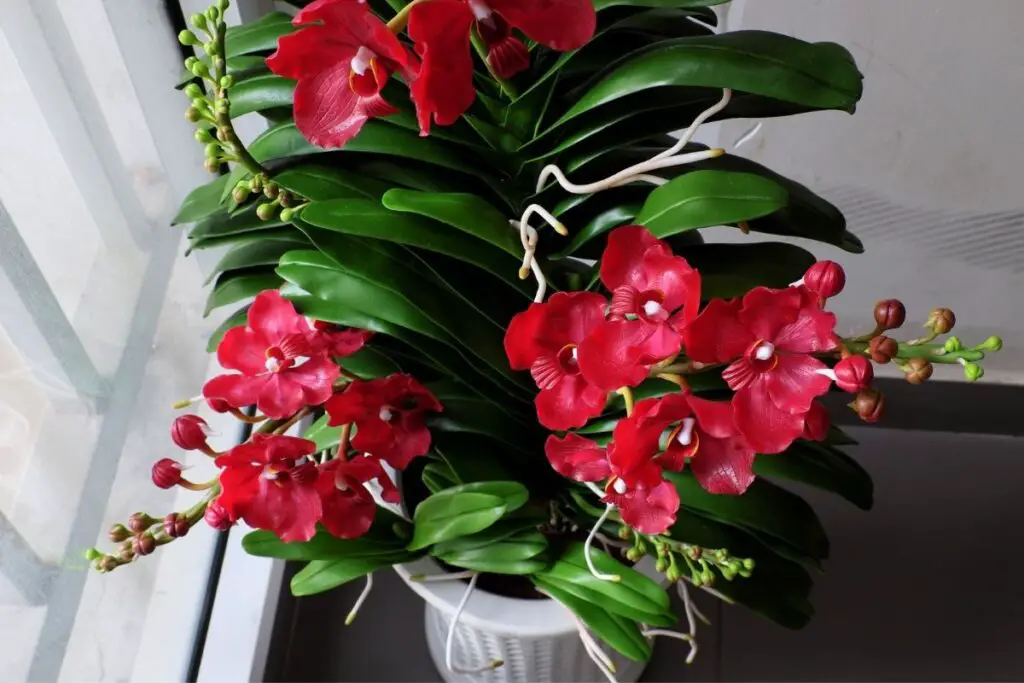
Orchids are everyone’s favorite flowers and are known to be high maintenance. We recommend choosing cheap orchids found in the local garden if you want them alive. They can be grown in containers but will survive if taken care of properly.
Sunlight: Orchids prefer indirect light to grow to its optimal. Keep them in a spot where they can receive light for a minimum of 10-11 hours a day. If there is less light availability, then use grow lights or light bulbs to fulfill the plant’s light needs.
Watering: Water orchids thoroughly to allow excess water to drain out of the drainage system. Do not water the flowers but from the soil, and use distilled water to avoid any film buildup in the leaves.
Fertilizer: Fertilize orchids with orchid fertilizer once a month in the growing season. Avoid over-fertilizing.
General care: Orchids prefer temperatures between 70°F to 80°F. They should be grown indoors away from intense conditions outdoors as they are delicate plants.
Peonies
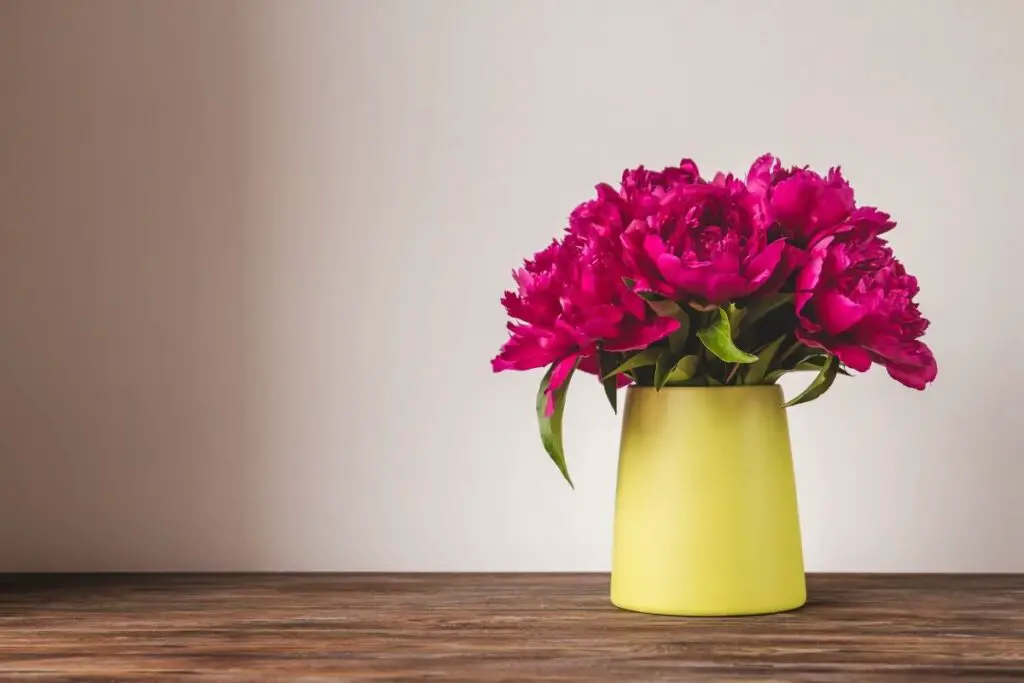
Peonies are low-maintenance plants with colorful and scented blooms. They grow well in containers but need room for their deep root system to develop properly. Flowers come in different colors like pink, red, white, yellow, purple, or orange.
Sunlight: Keep peonies in full sun if you want healthy foliage and flowers. Low light will inhibit your plant growth and flowering.
Watering: Water peonies when the soil is dry but do not let it bone dry. Ensure proper drainage and avoid prolonged moistness in the soil, leading to root rot. They are drought-resistant but sensitive to over-watering.
Fertilizer: Fertilize orchids by adding compost to the soil before planting them. During spring, fertilize it once with balanced liquid or granular fertilizer.
General care: Orchids prefer cool climates with good light availability. Avoid transplanting peonies in regular intervals and transplant when matured. Trim the plant but keep as much foliage as you can because it stores energy required during the dormant period.
Reference: Louisiana State University Agricultural Center, University of Kentucky, MSU, University of New Hampshire Cooperative Extension.
